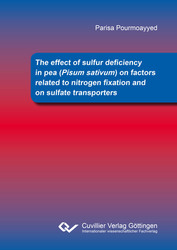| Fachbereiche | |
|---|---|
| Buchreihen (96) |
1378
|
| Nachhaltigkeit |
3
|
| Gesundheitswesen |
1
|
| Geisteswissenschaften |
2365
|
| Naturwissenschaften |
5406
|
| Mathematik | 229 |
| Informatik | 319 |
| Physik | 980 |
| Chemie | 1363 |
| Geowissenschaften | 131 |
| Humanmedizin | 243 |
| Zahn-, Mund- und Kieferheilkunde | 10 |
| Veterinärmedizin | 108 |
| Pharmazie | 147 |
| Biologie | 835 |
| Biochemie, Molekularbiologie, Gentechnologie | 121 |
| Biophysik | 25 |
| Ernährungs- und Haushaltswissenschaften | 45 |
| Land- und Agrarwissenschaften | 1004 |
| Forstwissenschaften | 201 |
| Gartenbauwissenschaft | 20 |
| Umweltforschung, Ökologie und Landespflege | 148 |
| Ingenieurwissenschaften |
1793
|
| Allgemein |
98
|
|
Leitlinien Unfallchirurgie
5. Auflage bestellen |
|
Erweiterte Suche
The effect of sulfur deficiency in pea (Pisum sativum) on factors related to nitrogen fixation and on sulfate transporters
Parisa Pourmoayyed (Autor)Vorschau
Inhaltsverzeichnis, PDF (43 KB)
Leseprobe, PDF (120 KB)
Sulfur has a vital role in the plant life cycle. S deficiency reduces optimal yield and quality in legumes which lead to a reduction in nutritional value of food and feed. S deficiency also alters the symbiotic interaction between leguminous plants and soil nitrogen fixing bacteria which leads to a decline in N2 fixation rate. An efficient symbiotic nitrogen fixation (SNF) in the nodule demands a strong nutrient exchange between plant and bacterial cells. The plant symbiotic sulfate transporter (SST) supports adequate S supply for full activity of nodules. In the present study, I investigated how different levels of S supply affect the protein and mRNA expression of genes related to N2 fixation in Pisum sativum. Moreover, different sulfate transporter genes were identified in pea and the functional analysis was performed for the symbiotic sulfate transporter from pea after expression in yeast double mutant. Growth retardation was observed in both weak and severe S deficient plants while severe S deficiency led to a significant decline in total biomass and shoot dry weight. Chlorosis and yellowish leaves in severe S deficient plant were observed as a consequence of a 43% decline in the chlorophyll content of young leaves in comparison with the control plants. Both weak and severe S deficiency reduced nodule formation. Thus, nodules appeared smaller and green with less leghemoglobin content in the S deficient groups. Relative transcript abundance of leghemoglobin genes (PsLb5 and PsLb120) did not change significantly under S deficiency conditions in the vegetative phase, thus confirming that expression of both genes is essential to create a low O2 concentration in young nodules. In contrast, severe S deficiency during the generative phase reduced expression of leghemoglobin at mRNA and protein levels. Furthermore, the higher leghemoglobin content in the generative phase is indicative for a higher leghemoglobin demand of mature nodules to maintain a low O2 environment and to protect the nitrogenase for an effective SNF. Nitrogenase is encoded by the nifHDK gene cluster. Severe S deficiency reduced the relative transcript abundance of the β subunits (NifK gene) while expression of α subunits (NifD gene) was mostly unaffected. S deficiency conditions increased relative transcript abundance of ferredoxin to compensate the S limitation in the nodule. Furthermore, a higher level of ferredoxin expression in the generative phase compared to the vegetative phase might be accompanied by a more SNF activity in the generative phase. In contrast to the nodule, relative ferredoxin transcript abundance was reduced under severe S deficiency in the root and leaf tissues supporting sulfite reduction and NADP photo-reduction. Both severe and weak S deficiencies reduced the relative transcript abundance of ferredoxin in the young leaves more than the mature leaves because the mature leaves are the main site of sulfate storage and assimilation. Severe S deficiency reduced expression of the nodule-specific sulfate transporter (SST) in both vegetative and generative phase of plant life which confirms a disruption in sulfate transport in symbiosomes. Phylogenetic analysis of 14-full length sulfate transporter sequences from pea and other known sulfate transporters from the leguminous family revealed that they fall into five major groups. In conclusion, a reduced sulfate import into the nodule probably reduces the sulfate related metabolites and interrupts the expression and biosynthesis of nitrogenase, leghemoglobin and ferredoxin proteins and eventually leads to an interruption of SNF. Moreover, severe S deficiency could limit the S compounds and S containing amino acids essential for the synthesis of critical products such as chlorophyll, thus leading to a lower rate of photosynthesis and fewer energy sources for an efficient yield.
| ISBN-13 (Printausgabe) | 9783736993044 |
| ISBN-13 (E-Book) | 9783736983045 |
| Buchendformat | A5 |
| Sprache | Englisch |
| Seitenanzahl | 116 |
| Umschlagkaschierung | matt |
| Auflage | 1. Aufl. |
| Erscheinungsort | Göttingen |
| Promotionsort | Bonn |
| Erscheinungsdatum | 25.07.2016 |
| Allgemeine Einordnung | Dissertation |
| Fachbereiche |
Land- und Agrarwissenschaften
|
| Schlagwörter | S deficiency, symbiotic nitrogen fixation, sulfate transporter, leghemoglobin, nitrogenase, ferredoxin |








